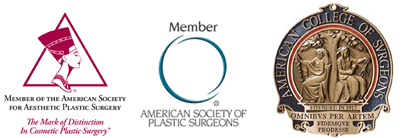
In the past, cosmetic nasal surgery had the tendency to be over-done and unnatural. Plastic surgeons tended to resect or remove too much cartilage from the nose, leading to unnatural and poor results. The cartilage of the nose and the bony framework act as the structural support to the nose. If too much of this is removed or sutured poorly, the final appearance of the nose can suffer. This can be seen in the result of Michael Jackson. His nose was “pinched” and had unnatural form and shape. His rhinoplasty result is a classic example of someone who had too much cartilage removed. This led to a collapse and loss of architectural integrity. With the latest and newest techniques, these types of appearances can be predominantly avoided. Major advances in rhinoplasty cosmetic surgery have occurred in the last two decades.
The most modern rhinoplasty surgery focuses on three important aspects to achieve the best and most natural results. The first is to resculpt, reshape, and reposition the nose with less aggressive tissue removal or resection. The second is emphasis on supporting the nasal framework for long term architectural stability. The third critical concept is to use grafts and internal stitches for structural tip shape and support.
1. Resculpt, Reshape, and Reposition the Nose with Less Aggressive Resection
The goal of a nose job or most cosmetic nasal surgery is a thinner, smaller, and more attractive nose. Resculpt means to form, to shape, or to manipulate the tissues into the desired appearance. The latest techniques emphasize achieving this without the extensive resection of cartilage and bone that was done in the past. This turned out to be problematic with a greater chance of poor long term results. The best or most attractive outcomes can be achieved without doing so much removal of tissue or damage. Emphasis is technically directed at recreating the new nose with sutures and repositioning the components of the nose. The lower lateral cartilages that make up the tip of the nose are reshaped to make the tip more thin, refined, and pretty. Reshaping the nose can be done by suturing and repositioning. The nasal tip can be elevated, shortened, or narrowed to give pleasing aesthetic lines and contours. The surgical techniques that are the newest focus on these methods.
2. Support the Nasal Framework
You can think of the nose anatomically and imagine it is similar to a tent. The skin of the nose is the fabric or canvas of the tent. The cartilage and bone of the nose holds up the skin like the tent poles hold up the tent canvas. The internal work done at the time of a rhinoplasty is done on the cartilage and bone. This is called the nasal framework. This framework supports the nose and skin much like the tent poles. If you take out too much tissue (over resection or removal), you can get collapse of the nose and shape changes in the final result that are not desired or wanted. One classic problem is a “pinched tip.” The aggressive resection in the past led to the tip looking overdone and pinched. With modern techniques the tip remains strong enough to maintain natural shape and appearance. The techniques include preservation of key components of the upper lateral cartilages and lower lateral cartilages. Going back to the “tent” analogy, the cosmetic surgeon should not remove too much of the tent poles supporting the tent or the tent will take on a weird or unnatural look. With the nose, the cosmetic surgeon must maintain support of the nasal framework, so the nose keeps a natural shape and avoids poor results.
3. Grafts and Internal Stitching for Structural Tip Support
New methods to shape the nasal tip include cartilage grafting and precise suturing or stitching. These methods have supplanted removal methods or over-resection techniques of the past. Grafting cartilage has become a prominent method of achieving the most precise and pretty tip. When a surgeon uses cartilage grafts, he finds small pieces of cartilage that are not necessary for nasal appearance. This might be from hidden parts of the septum. He then takes these small pieces of the cartilage and fashions the piece into the artistic and creative creation of the tip. The pieces are used to enhance and accentuate the beauty of the nose. The grafts are also used to stabilize the nose as a supportive element. Other techniques include fashioning the cartilage graft into a shape to provide better projection and lift to a desired area. This might mean adding shape and definition to specific parts or locations on the nasal tip. Cartilage grafts have different names such as alar, batten, spreader, crushed, and tip grafts. It can be truly creative and artistic to use the grafts to precisely and meticulously redefine and shape the new nose. It’s one of the reasons I like rhinoplasty surgery so much! The operation is one of the most artistic and skillful of many cosmetic procedures.
Finally, I want to emphasize two additional aspects of the latest nose job methods. The first is the open rhinoplasty versus a closed technique. The second is the use of computer imaging to help with patient’s understanding of results and realistic expectations. The open method to perform a nose job means that a small incision is placed in the columella of the nose. The columella is the area of the nose below the tip and heading down to the lip. In the past the entire operation was done without this incision. It was more of a blind procedure where exact tip suturing and sculpting was much more difficult. The open technique allows for the skin to be elevated and more meticulous and precise suturing and grafting can be performed for structural tip support. The open method has predominantly replaced the closed method, because it provides more control and delivers a more consistent and reproducible result.
Computer imaging is, in my opinion, a fabulous tool to help the patient pick his or her new nose. It can show a patient what can and can not be achieved with surgery. The computer program is a sophisticated and advanced program to manipulate the image and show possible options with surgery. By placing the before and “photo-shopped” images side by side, the patient can really get an idea of changes possible for him or her. It also helps the patient get realistic expectations about true changes that can be achieved. I think it is a fantastic tool for the surgeon to use to help patients get the best results with their rhinoplasty.
I am a board certified plastic surgeon who practices exclusively cosmetic surgery. Please come in for a complimentary consultation. Details of your cosmetic procedure will be discussed completely. I hope this writing helps with your understanding of the latest techniques of rhinoplasty.

